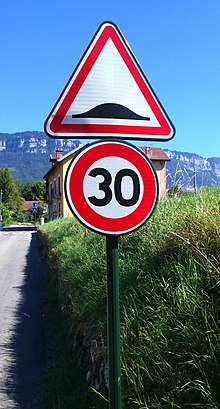Kilometer per hour
The kilometer per hour is a unit of measurement of speed, both scalar and vectorial. An object travels at an average speed of 1 km/h if it moves 1 kilometer in one hour.
The symbol used for this unit is km/h, although the notation kph is also used in some English-speaking countries.
This unit of measurement does not belong to the International System of Units (SI). The SI derived unit for velocity is the meter per second (m/s). However, it is the most widely used unit worldwide to indicate speeds in land transport, be it road transport or rail transport. kWh and km/h are the most widely used units that are based on the hour. Time is the only non-SI unit that is accepted for use with SI units by the International Bureau of Weights and Measures.
Equivalences with other units
- 3.6 km/h = 1 m/s
- 60 km/h = 1 km/min
- 3600 km/h = 1 km/s
- 1 km/h = 0.27778 m/s
- 1 km/h = 0.62137 mph = 0.91134 ft/s
- 1 knot = 1,852 km/h
- 1 mile per hour = 1,609344 km/h
Examples
| 3-5 km/h | Speed of walking an average human. |
| 8 km/h | Speed of the trot of an average human. |
| 15 km/h | Speed running from an average human. |
| 20 km/h | Commercial speed of fret train in France |
| 28 km/h | Speed of a bicycle. |
| 30 km/h | Motorcycle speed. Zone 30 in residential areas in Europe. |
| 40 km/h | Speed that reaches an elite athlete in the 100 meters smooth. |
| 50 km/h | Limit speed in the city avenues and roads in several European countries |
| 60 km/h | Transit limit speed in residential areas. |
| 70 km/h | Speed of hazardous areas in several European countries |
| 80-90 km/h | Limit speed on some avenues and roads. |
| 100 km/h | Limit speed of interurban buses on some routes, mainly highways. |
| 110-120 km/h | Limit speed on some routes, mainly highways. |
| 200-250 km/h | Limit between conventional speed trains and high-speed trains according to the International Union of Railways and the Directive (EU) 96/48/EC, Annex 1. |
| 293 km/h | Speed (speed log) Train pendolino |
| 300-380 km/h | Commercial speeds reaching high-speed trains and Maglev: 300, 320 and 350 |
| 387 km/h | Speed (speed cord) Hyperloop one |
| 575 km/h | High-speed rail (speed rail) in France |
| 430-603 km/h | Speed (speed string) reach maglevs (501 in China, 603 in Japan) |
| 800-1000 km/h | Speed of passengers. |
| 1235 km/h | Sound speed in air at 20 °C, with 50% humidity and sea level. |
| 2000 km/h | Speed of some combat planes. |
| 23 039 km/h | Sound speed in aluminum. |
| 30 000 km/h | Average speed of a spacecraft traveling in space. |
| 40 320 km/h | Earth's escape speed. |
| 70 000 km/h | Speed that could reach an asteroid that impacted the Earth. |
| 107 208 km/h | Earth's speed in transit around the Sun. |
| 255 600 km/h | Maximum detected speed of the comets. |
| 468,000 km/h | Translating speed of the Milky Way. |
| 792 000 km/h | Translating speed of the Sun in the Milky Way. |
| 1 080 000 000 km/h | Light speed. |
Contenido relacionado
Hydrostatic
Public Library of Science
Nuclear magnetic resonance
